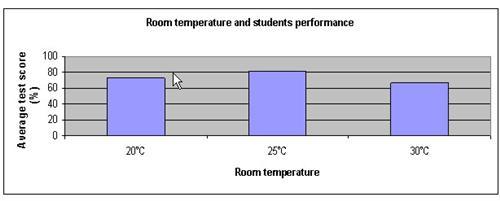| Complexity level: | 5 |
| Project cost ($): | 20 |
| Time required: | 1 day to prepare, 3 days for science project experiment |
| Material availability: | Easily found |
| Safety concerns: | None |
Hypothesis
Students will perform better in the tests when the classroom is at a temperature of 20°C.
Overview
Temperature and performance
Lower classroom temperatures and improved air ventilation have been found to improve the learning ability of students. They can help students better their performance by as much as 10 to 20 percent. Lower classroom temperatures and improved air ventilation also help students to perform better at their school exams. Studies have show that students in classrooms with lower temperatures are able to do their work more quickly and make fewer mistakes.
In warm classrooms, students are easily distracted by the discomfort they experience and hence are not able to fully concentrate on their lessons. Warmer temperature tend to make students feel tired and lethargic, as compared to cooler temperatures which help them stay alert. On the other hand, the temperature in the classroom should not be extremely cold.
The temperature in the classroom should be at a level where the students feel comfortable, and are able to better concentrate on the lesson.
Scientific Terms
Materials
The materials required for this science fair project:
- 25 students age 16
- Three 800 word essays of equal difficulty
- 3 sets of test papers of equal difficulty – a test paper for each essay
- An air-conditioned classroom
- An English teacher
- A clock or watch
- A thermometer to measure the temperature of the classroom
Procedure
1. For this science fair project, the independent variable is the classroom temperature, i.e. 20°C, 25°C and 30°C. The dependent variable is how well the students perform in the test. This is determined by calculating the average marks obtained after marking and grading the test papers. The constants (control variables) are the difficulty of the test, the length of the essay and the number of questions.
2. Three essays of equal difficulty are selected. Each essay will have about 800 words. With the help of an English teacher, 10 test questions are prepared for each essay. 25 copies of the essay and the test papers are prepared.
3. On the 1st day, the 25 students are brought into the classroom to be tested. The classroom temperature is brought to 20°C. This is verified using the thermometer. They are given 30 minutes to read the 1st essay and another 30 minutes to answer the 10 questions. After the 30 minutes, the test papers are collected.
4. On the 2nd day, the classroom temperature is brought to 25°C. This is verified using the thermometer. They are given the 2nd essay to read for 30 minutes and another 30 minutes to answer the test questions.
5. On the 3rd day, several hot plates are placed around the classroom to bring the room temperature to 30°C. This is verified using the thermometer. The students are given 30 minutes to read the essay and another 30 minutes to answer the questions on the test paper.
6. With the help of an English teacher, the 75 test papers are graded and the average results for the tests held at each classroom temperature are recorded in the table below.

Results
The results show that the students who scored the highest test marks were in the classroom at room temperature 25°C
| Room temperature | 20°C | 25°C | 30°C |
| Average test scores | 77 | 81 | 72 |
Use the below graph to plot the results of above observation

Conclusion
The hypothesis that students will perform better when the classroom is at a temperature of 20°C is not correct.
Not everyone is comfortable at the same level of temperature in the classroom. What is comfortable for one person may be too warm or too cold for another person. In our experiment, it is possible that some students felt too cold at a temperature of 20°C whilst it is very likely that all of the students were too hot to be able to concentrate effectively at 30°C. Therefore, it is better to set a lower temperature so that students who find it too cold are able to simply put on a sweater or jacket to keep themselves warm. This will create a comfortable environment for all
Also consider
The science fair project can also be repeated to compare whether a change in classroom temperature affects males and females differently.
References
Lower temperatures, increased ventilation boost student performance - http://www.ashrae.org/pressroom/detail/15880
Is your academic performance tied to classroom temperature? - http://www.studentstuff.com/2010/03/24/is-your-academic-performance-tied-to-classroom-temperature

